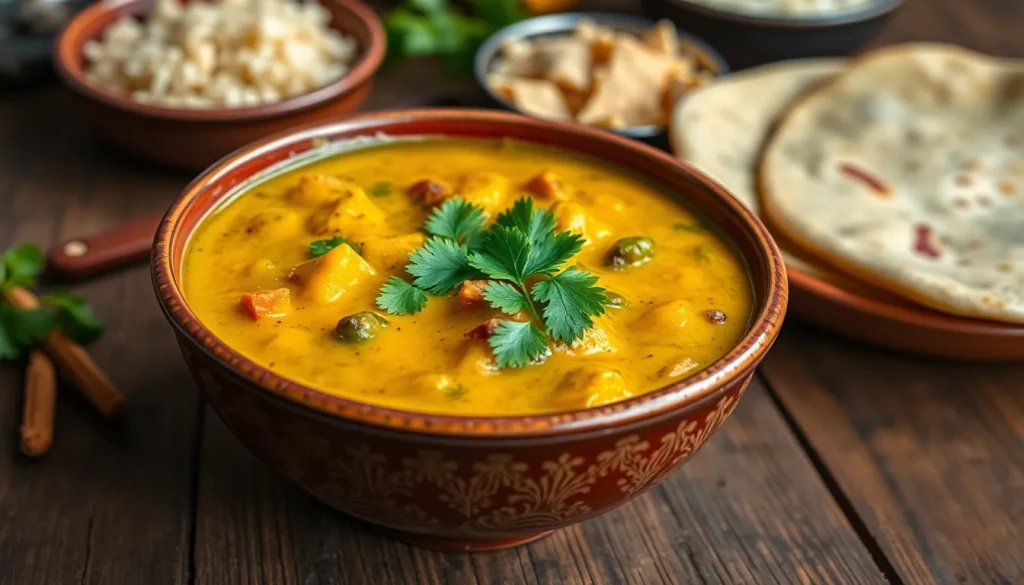Table of Contents
ToggleIn the bustling world of culinary delights, few dishes can claim the spotlight quite like jharaahar. This vibrant, flavorful creation isn’t just a meal; it’s an experience that dances on the taste buds and warms the soul. Imagine a dish so packed with spices that even your taste buds might throw a party!
Overview of Jharaahar
Jharaahar serves as a kaleidoscope of flavors and aromas combining various ingredients and spices. This dish thrives on its unique blend of spices like turmeric, cumin, and coriander, creating an irresistible taste profile. Each bite reveals layers of complexity, making it a beloved choice among food enthusiasts.
Originating from rich culinary traditions, jharaahar reflects the heart of its culture. Many chefs craft this dish using fresh, locally sourced vegetables, enhancing its natural taste. The cooking process involves slow simmering, allowing flavors to meld together harmoniously.
Various regional variations exist, showcasing diverse ingredient combinations and cooking methods. In one region, chefs might incorporate lentils, while others may choose to add seasonal vegetables. This flexibility allows jharaahar to adapt while retaining its essence.
Serving jharaahar often involves pairing it with rice or flatbread, enhancing the dining experience. This approach ensures that each meal provides a balanced presentation. Many enjoy it during family gatherings, highlighting its significance as a comfort food.
The popularity of jharaahar extends beyond home cooking; it frequently appears on restaurant menus. High demand has led to creative interpretations, appealing to contemporary palates. Chefs explore innovative ways to present this timeless dish, invoking both nostalgia and excitement.
Ultimately, jharaahar transcends mere sustenance. It invites culinary exploration while fostering connections among diners. This dish celebrates shared experiences through flavors that resonate with many cultures.
Historical Significance

Jharaahar holds deep roots in its cultural and culinary history. This dish represents a fusion of tradition and innovation, celebrating local ingredients and long-standing customs.
Origin and Cultural Context
Jharaahar’s origin traces back to diverse regions, where each community added its unique touch. Local farmers often contributed fresh vegetables and spices, leading to distinctive regional flavors. Celebrated during festivals, jharaahar strengthens familial bonds as families gather around shared meals. It serves as a symbol of hospitality, with hosts eagerly preparing this dish to honor their guests. The use of spices reflects not only culinary choices but also historical trade routes that influenced local cuisines.
Evolution Over Time
The evolution of jharaahar showcases its adaptability throughout culinary history. From traditional kitchens to modern restaurants, chefs continually reinterpret this dish to meet contemporary tastes. Numerous variations have emerged, incorporating ingredients such as gluten-free grains or plant-based proteins, catering to current dietary trends. Innovations in cooking techniques also play a vital role, with some chefs employing faster methods like pressure cooking while retaining classic flavors. The dish’s journey through time demonstrates its enduring appeal and ability to transcend cultural boundaries, captivating new generations.
Features of Jharaahar
Jharaahar possesses distinctive features that enhance its appeal. It stands out for its vibrant colors and inviting aromas that whet the appetite.
Physical Characteristics
Jharaahar displays a rich tapestry of colors, often reflecting the spices used. Bright yellow turmeric and deep green coriander create a visually striking dish. The textures vary, offering creaminess from lentils or smoothness from cooked vegetables. Each bite provides a sensory experience, as the dish combines tender ingredients with spices that create warmth and depth. Aromatic herbs contribute to the overall sensory allure, drawing diners in with enticing scents.
Unique Selling Points
Jharaahar’s uniqueness lies in its authentic flavor profile, distinguished by its signature spice blend. Customizable with various regional ingredients, it caters to diverse palates by incorporating seasonal vegetables and proteins. Cultural significance elevates the dish beyond mere sustenance, making it a symbol of hospitality during gatherings. Its versatility allows chefs to make it accessible by adapting to dietary preferences, such as vegetarian or gluten-free options. Finally, the rich culinary heritage associated with jharaahar invites exploration and appreciation from food enthusiasts around the world.
Jharaahar in Modern Usage
Jharaahar remains a celebrated dish in contemporary culinary scenes. Its unique flavors and rich history resonate with food lovers and chefs alike.
Popularity and Trends
Interest in jharaahar continues to grow, especially in urban areas. Diners seek out traditional recipes alongside innovative twists. Food trends highlight the incorporation of organic vegetables and gluten-free grains, appealing to health-conscious consumers. Food festivals frequently showcase jharaahar, drawing attention to its versatility and adaptability. Social media platforms buzz with vibrant photos of the dish, further driving its popularity. Local restaurants often include jharaahar on their menus, blending traditional and modern culinary techniques to attract diverse patrons.
Comparison with Similar Products
Jharaahar stands out when compared to similar dishes, such as dal or curries. Unlike these options, jharaahar features a complex blend of spices that creates multiple flavor layers. Its texture varies significantly, offering a combination of creaminess from lentils or smoothness from cooked vegetables. Many curry dishes emphasize a singular flavor profile, while jharaahar’s vibrant colors and aromas enhance the dining experience. Adaptability also sets jharaahar apart, as it caters to various dietary preferences, including vegetarian or gluten-free. Chefs often use jharaahar as a base, allowing for experimentation with ingredients and cooking methods, making it a more versatile option in the culinary world.
Jharaahar embodies the essence of culinary heritage while embracing modern twists. Its vibrant flavors and rich history make it a dish that not only satisfies hunger but also fosters connection among those who share it. As food enthusiasts continue to explore its diverse variations, jharaahar remains a testament to the beauty of cultural fusion in the kitchen. This dish invites everyone to experience its warmth and complexity, ensuring it will hold a special place in dining traditions for years to come. Whether enjoyed at home or in a bustling restaurant, jharaahar is sure to leave a lasting impression on all who indulge in its delightful offerings.



